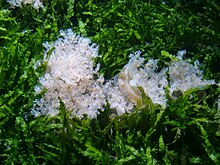| Revision as of 21:23, 8 April 2021 editCitation bot (talk | contribs)Bots5,444,639 edits Add: authors 1-1. Removed parameters. Some additions/deletions were parameter name changes. | Use this bot. Report bugs. | Suggested by Jonesey95 | via #UCB_webform 854/2500← Previous edit | Revision as of 18:54, 10 May 2021 edit undoPlantdrew (talk | contribs)Autopatrolled, Extended confirmed users, New page reviewers645,621 edits →Species: linkNext edit → | ||
| Line 19: | Line 19: | ||
| * '']'' <small>(Forsskål, 1775)</small> | * '']'' <small>(Forsskål, 1775)</small> | ||
| * ''Cassiopea depressa'' <small> Haeckel, 1880</small> | * '']'' <small> Haeckel, 1880</small> | ||
| * ''Cassiopea frondosa'' <small>(Pallas, 1774)</small> | * '']'' <small>(Pallas, 1774)</small> | ||
| * ''Cassiopea maremetens'' <small>Gershwin, Zeidler & Davie, 2010</small> | * '']'' <small>Gershwin, Zeidler & Davie, 2010</small> | ||
| * ''Cassiopea medusa'' <small>Light, 1914</small> | * '']'' <small>Light, 1914</small> | ||
| * ''Cassiopea mertensi'' <small>Brandt, 1838</small> | * '']'' <small>Brandt, 1838</small> | ||
| * ''Cassiopea ndrosia'' <small>Agassiz & Mayer, 1899</small> | * '']'' <small>Agassiz & Mayer, 1899</small> | ||
| * '']'' <small>Haeckel, 1880</small> | * '']'' <small>Haeckel, 1880</small> | ||
Revision as of 18:54, 10 May 2021
Genus of jellyfishes Not to be confused with Cassiopeia (disambiguation).
| Cassiopea | |
|---|---|

| |
| Cassiopea sp. | |
| Scientific classification | |
| Domain: | Eukaryota |
| Kingdom: | Animalia |
| Phylum: | Cnidaria |
| Class: | Scyphozoa |
| Order: | Rhizostomeae |
| Family: | Cassiopeidae Agassiz, 1862 |
| Genus: | Cassiopea Péron & Lesueur, 1809 |
| Species | |
|
8 species, see text | |

Cassiopea (upside-down jellyfish) is a genus of true jellyfish and the only members of the family Cassiopeidae. They are found in warmer coastal regions around the world, including shallow mangrove swamps, mudflats, canals, and turtle grass flats in Florida, and the Caribbean and Micronesia. The medusa usually lives upside-down on the bottom, which has earned them the common name. These jellyfish partake in a symbiotic relationship with photosynthetic dinoflagellates and therefore, must lay upside-down in areas with sufficient light penetration to fuel their energy source. Where found, there may be numerous individuals with varying shades of white, blue, green and brown.
Species
According to the World Register of Marine Species, this genus includes 8 species:
- Cassiopea andromeda (Forsskål, 1775)
- Cassiopea depressa Haeckel, 1880
- Cassiopea frondosa (Pallas, 1774)
- Cassiopea maremetens Gershwin, Zeidler & Davie, 2010
- Cassiopea medusa Light, 1914
- Cassiopea mertensi Brandt, 1838
- Cassiopea ndrosia Agassiz & Mayer, 1899
- Cassiopea ornata Haeckel, 1880
Also recognized:
- Cassiopea xamachana Bigelow, 1892
Defence system
Cassiopea species have a mild sting since they are primarily photosynthetic, but sensitive individuals may have a stronger reaction. The photosynthesis occurs because, like most corals, they host zooxanthellae in their tissues. The stinging cells are also found in cellular masses, dubbed "cassiosomes", excreted in a mucus; swimmers swimming near the jellyfish may come in contact with these cassiosomes and be stung. The stings, appearing in the form of a red rash-like skin irritation, are known for being extraordinarily itchy. Sometimes this jellyfish is picked up by the crab Dorippe frascone and carried on its back. The crab uses the jellyfish to defend itself against possible predators.
Behavior
Certain species of Cassiopea have been observed to enter a sleep state - exhibiting decreased pulsation rate, reduced responsiveness to stimuli, and compensatory rebound sleep after deprivation.
References
- "Cassiopeidae". WoRMS. World Register of Marine Species. Retrieved 3 August 2012.
- Ohdera Aki H.; Abrams Michael J.; Ames Cheryl L.; Baker David M.; Suescún-Bolívar Luis P.; Collins Allen G.; Freeman Christopher J.; Gamero-Mora Edgar; Goulet Tamar L.; Hofmann Dietrich K.; Jaimes-Becerra Adrian; Long Paul F.; Marques Antonio C.; Miller Laura A.; Mydlarz Laura D.; Morandini Andre C.; Newkirk Casandra R.; Putri Sastia P.; Samson Julia E.; Stampar Sérgio N.; Steinworth Bailey; Templeman Michelle; Thomé Patricia E.; Vlok Marli; Woodley Cheryl M.; Wong Jane C.Y.; Martindale Mark Q.; Fitt William K.; Medina Mónica (2018). "Upside-Down but Headed in the Right Direction: Review of the Highly Versatile Cassiopea xamachana System". Frontiers in Ecology and Evolution. 6: 35. doi:10.3389/fevo.2018.00035.
- "Cassiopea". WoRMS. World Register of Marine Species. Retrieved 3 August 2012.
- Murphy, Richard C. (2002). Coral Reefs: Cities Under The Sea. Princeton, New Jersey: The Darwin Press. ISBN 978-0-87850-138-0.
- Ames, Cheryl L.; Klompen, Anna M. L.; Badhiwala, Krishna; Muffett, Kade; Reft, Abigail J.; Kumar, Mehr; Janssen, Jennie D.; Schultzhaus, Janna N.; Field, Lauren D.; Muroski, Megan E.; Bezio, Nick (2020-02-13). "Cassiosomes are stinging-cell structures in the mucus of the upside-down jellyfish Cassiopea xamachana". Communications Biology. 3 (1): 67. doi:10.1038/s42003-020-0777-8. ISSN 2399-3642. PMC 7018847. PMID 32054971.
- "Stinging water mystery solved: Jellyfish can sting swimmers, prey with 'mucus grenades'". Phys.org. February 13, 2020. Retrieved February 14, 2020.
- "The surprising, ancient behavior of jellyfish". EurekAlert. Retrieved 22 September 2017.
External links
- Photo of a Crab carrying an Upside Down Jellyfish (Cassiopea andromeda)
- Bernice Pauahi Bishop Museum entry on Cassiopea andromeda
- A Symbiotic Lifestyle: C. xamachana and Zooxanthellae
| Taxon identifiers | |
|---|---|
| Cassiopea | |